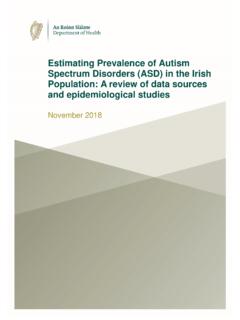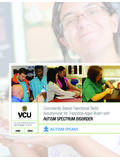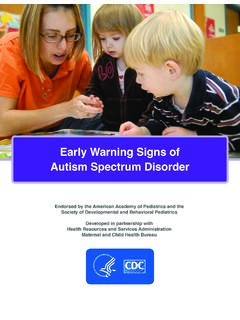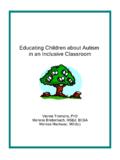Transcription of Classrooms with Autism Spectrum Disorder in Mainstream ...
1 Full Terms & Conditions of access and use can be found by: [University of Strathclyde]Date: 24 February 2017, At: 06:37 International Journal of Disability, Development andEducationISSN: 1034-912X (Print) 1465-346X (Online) Journal homepage: Challenges of Including Childrenwith Autism Spectrum Disorder in MainstreamClassroomsSally Lindsay, Meghann Proulx, Nicole Thomson & Helen ScottTo cite this article: Sally Lindsay, Meghann Proulx, Nicole Thomson & Helen Scott (2013)Educators Challenges of Including Children with Autism Spectrum Disorder in MainstreamClassrooms, International Journal of Disability, Development and Education, 60:4, 347-362, link to this article: online: 09 Dec your article to this journal Article views: 5516 View related articles Citing articles: 1 View citing articles Educators Challenges of Including Children with Autism SpectrumDisorder in Mainstream ClassroomsSally Lindsay*, Meghann Proulx, Nicole Thomson and Helen ScottBloorview Research Institute, Holland Bloorview Kids Rehabilitation Hospital,The University of Toronto, Toronto, ON, CanadaAlthough children with Autism Spectrum Disorder (ASD) are increasingly beingplaced within Mainstream classes, little is known about the challenges that teachersencounter with including them as full participants in the class.
2 This qualitative studydraws on a purposive sample of 13 educators who have experience teaching childrenwith ASD within two cities in Ontario, Canada. Through in-depth interviews weasked about teachers challenges regarding creating an inclusive environment withintheir classroom. Teachers reported several challenges, including: understanding andmanaging behaviour; socio-structural barriers ( , school policy, lack of training andresources); and creating an inclusive environment ( , lack of understanding fromother teachers, students and parents). Teachers recommend that more resources,training and support are needed to enhance the education and inclusion of childrenwith :Asperger s; Autism Spectrum Disorder ; children; inclusive education; Mainstream classroom; qualitative research; social inclusion; teachersIntroductionEducators have reported a notable increase in students with Autism over the past few years(Geneva Centre for Autism , 2010; Lindsay et al.)
3 , 2013). Autism Spectrum Disorder (ASD)is one of the most common childhood neurological disorders ( Autism Society Canada,2010), which is characterised by problems in communication ( , delay or lack of lan-guage development), social development ( , lack of development of peer relationships,impaired non-verbal behaviour), ritualistic behaviour and resistance to change (AmericanPsychiatric Association, 2012). With more students with ASD in Mainstream Classrooms ,educators are expected to create an inclusive educational environment, often with few orno guidelines on how to do so (Horrocks, White, & Roberts, 2008; Lindsay et al., 2013).Researchers have also highlighted that many schools are struggling to keep pace in meet-ing the needs of students with ASD (Humphrey & Lewis, 2008; Symes & Humphrey,2010). Many teachers and parents agree that more needs to be done to create inclusivesocial environments within Classrooms (Hinton, Sofronoff, & Sheffield, 2008; McGregor& Campbell, 2001; Smith & Brown, 2000).
4 Despite these obstacles, very little is knownabout educators challenges with teaching children with on inclusive education shows that successful implementation of inclusiveprinciples can lead to increased student engagement in social interaction, higher levels*Corresponding author. Email: Journal of Disability, Development and Education, 2013 Vol. 60, No. 4, 347 362, 2013 Taylor & Francisof social support, social networks and advanced education goals compared with theircounterparts in segregated settings (Bredekamp & Copple, 1997; Chandler-Olcott &Kluth, 2009; Eldar, Talmor, & Wolf-Zukerman, 2010; Vakil, O Connor, & Kline, 2009).Despite these potential benefits, the inclusion of children with ASD in the mainstreamclassroom can be challenging for the social and behavioural impairments of children with ASD, teachers oftenface considerable obstacles in appropriately managing their needs (Bowe, 2004;Wilmhurst & Brue, 2010; Lindsay et al., 2013).
5 Evidence consistently shows that manyteachers feel unprepared to support students with ASD socially, academically, andbehaviourally (Hinton et al., 2008; Horrocks et al., 2008; Symes & Humphrey, 2010).Indeed, one of the most important challenges in working with students with Autism inintegrated Classrooms is inadequate knowledge about ASD and lacking access to con-sultation support and advice (De Boer & Simpson, 2009). For example, one UK-basedstudy found that only 5% of teachers received training about Autism even though themajority of teachers had a child with Autism in their class (McGregor & Campbell,2001). Such gaps in training can leave teachers feeling discouraged while students withASD may miss opportunities to reach their full potential (Allen & Cowdery, 2005; War-nock, 2005). Past research has typically focused on the challenges of managing individ-ual behaviours in attempting to include children with ASD in the classroom. This studyaddresses an important gap in the literature by also exploring the socio-structural factorsinfluencing the inclusion of these children.
6 As afirst step in building a more inclusiveenvironment where children are all considered an equally valued member of the class(Eldar et al., 2010), it is critical to understand the challenges educators may encounterwhen creating inclusive classroom environments, particularly for children with Ontario, Canada, where this study was conducted, school boards are required toprovide students with exceptionalities ( , behavioural, communication, intellectual,physical or multiple) with appropriate special education programmes and services tobest meet their educational needs (Lindsay, Proulx, Scott, & Thomson, 2013; OntarioMinistry of Education, 2012). Such students may receive these services once anIdentification, Placement and Review Committee have formally identified them (OntarioMinistry of Education, 2012; Lindsay et al., 2013).Within Ontario, Canada, the Ministry of Education has identified the inclusion ofstudents with ASD in school environments as an area of priority for action (Lindsayet al.)
7 , 2013; Minister s ASD Reference Group, 2007). Other researchers also highlightthe need to develop a better understanding of educators challenges in working withchildren who have ASD (Davis & Florian, 2004; Humphrey & Parkinson, 2006;National Autism Society, 2003). The Ontario Ministry of Education (2012) has sup-ported this inclusive approach with the Education Act and a commitment to supportchildren with disabilities in the Ontario school curriculum (Lindsay et al., 2013).Theoretical Perspective: Inclusive educationThe provision of inclusive and accepting social climates within schools is necessary tohelp children reach their full potential and for them to feel important, welcome, andappreciated (De Winter, Baeveldlt, & Kooistra, 1999). The United Nations Conventionon the Rights of the Child (1989) stipulates that all children, should enjoy a full anddecent life, in conditions which ensure dignity, promote self-reliance and facilitate thechild s active participation in the community (Article 23).
8 We draw on Lipsky andGartner s (1997) model on the essential elements of inclusion to inform our Lindsayet model outlines seven essential elements that can be used to guide an inclusiveeducation programme. These elements include: visionary leadership, collaboration, refo-cused use of assessment, support for staff and students, funding, effective parentalinvolvement as well as curricular adaptation and effective instructional practices. Thismodel offers a framework by which inclusion can be achieved (Lynch & Irvine, 2009),and is consistent with Ferguson s (1995) concept of authentic inclusion where organ-ising an education programme based on these elements can meet the needs of all stu-dents. We argue that applying best-practice elements of inclusion may be difficult forteachers who are including students with high-functioning Autism within their qualitative design explored educators challenges in and strategies for includingchildren with ASD in Mainstream Classrooms (see Lindsay et al.)
9 [2013] for methodsandfindings on strategies) while applying Lipsky and Gartner s (1997) model of essen-tial elements of inclusion. Ethical approval was obtained from the ethics review boardsat a children s hospital and two local district school study drew on a purposive sample of educators to gain a better understanding ofthe challenges they experience when including children with ASD in their were recruited through contacts with a local district school board. Informationletters were given to contacts of designated schools. Once the school board approvedthe project, information letters were sent to teachers who were thought to meet theinclusion criteria (see below). Participants who were interested in taking part contactedthe research team to set up a convenient time to be interviewed. Each participant wasscreened by telephone to determine eligibility prior to the interview. Participants wereincluded if they met the following criteria: they had at least two years of teaching expe-rience in an integrated class; they are currently an educator within an elementary schoolwithin a local district school board; and/or they have experience teaching a student withASD within a Mainstream class (Lindsay et al.
10 , 2013).Our sample consisted of 13 educators (10 females, three males) who taught a widerange of classes (see Table 1) (Lindsay et al., 2013). While current teaching roles maynot necessarily have been within a regular classroom ( , one teacher was currentlyemployed in a developmental disability programme, and six teachers were working in aspecial education room), each educator interviewed was asked to draw on their previousexperiences, ranging from three to 22 years, teaching in a Mainstream classroom. Satu-ration was reached when no new or relevant data emerged (Strauss & Corbin, 1998).Five of the teachers were based at a school in a rural area while eight were at an urbanschool setting. Twelve of the teachers had earned additional qualifications in specialeducation (Lindsay et al., 2013).Data GatheringThe interviews followed an in-depth, semi-structured format exploring teachers challenges on including children with ASD in Mainstream Classrooms .









